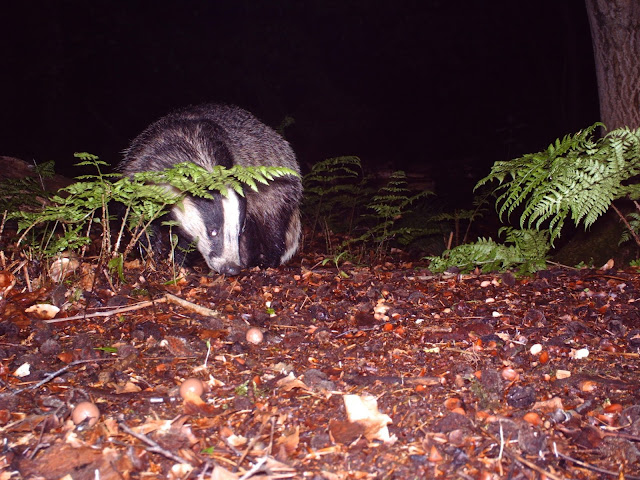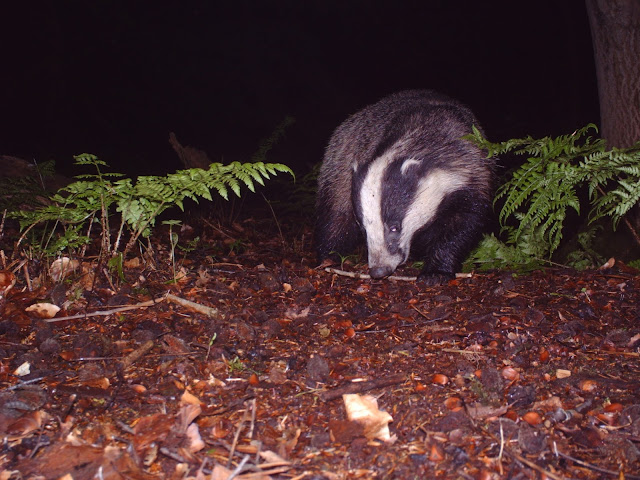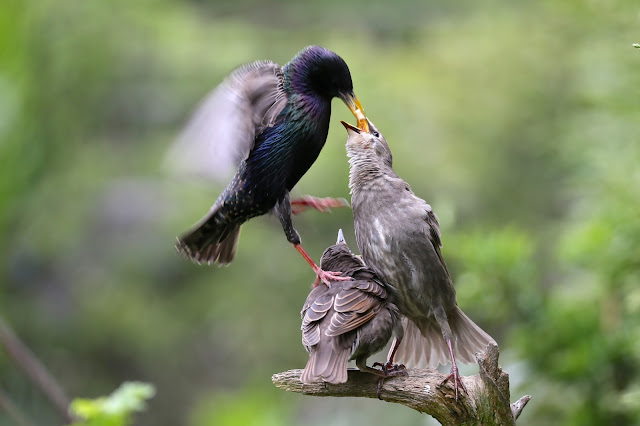My Blog List
Wednesday 31 May 2017
MalteserCam II
Another night in the woods with the trail camera. As before it was baited with peanuts and Maltesers. The first badger entered stage left. Below you can see a dozen or so Maltesers in front of him.
The next photo was taken two minutes later and he has eaten most of them.
That left three nearest the camera.
He's onto them.
Then there were two.
One left.
And that's the lot.
A few minutes later the first cub I have seen on the camera turned up hoping for a Malteser but the only photo was of a rather soggy tail end.
Two hours later a different badger stopped by but I think all the food had gone.
Later a fox looked in from the path but didn't stop.
And finally a wood mouse, hoping that a peanut had been overlooked.
Tuesday 30 May 2017
Oystercatcher news
Having got over the initial surprise and excitement, I am now getting used to having an oystercatcher in the garden. It visits several times every day, usually early morning or in the evening, presumably because there are fewer golfers and dog walkers around.
It usually does a big circuit of the main lawn outside the kitchen window.
It comes so close to the house that I lose sight of it below the window. The window is open and the bird must be aware of me and the camera.
When it flies off with a worm it can return in less than a minute so I think it must be nesting close by. Judging by the direction in which it flies, I reckon the most likely place is on the roof of the haulage depot across the road - 150m away as the oystercatcher flies. Unlike most waders, oystercatchers feed their chicks for some time after hatching. The chicks are precocial (hatched with eyes open, downy feathers and able to walk and leave the nest within a couple of days) but don't feed themselves. Oystercatchers generally nest on gravel on the coast or by water inland but recently they have been using flat roofs. The advantage is that there are no foxes or similar predators. The disadvantage is that eventually the chicks have to jump or fly off but as they are fed by the parents they can wait until they are big enough to do that.
It usually does a big circuit of the main lawn outside the kitchen window.
It comes so close to the house that I lose sight of it below the window. The window is open and the bird must be aware of me and the camera.
When it flies off with a worm it can return in less than a minute so I think it must be nesting close by. Judging by the direction in which it flies, I reckon the most likely place is on the roof of the haulage depot across the road - 150m away as the oystercatcher flies. Unlike most waders, oystercatchers feed their chicks for some time after hatching. The chicks are precocial (hatched with eyes open, downy feathers and able to walk and leave the nest within a couple of days) but don't feed themselves. Oystercatchers generally nest on gravel on the coast or by water inland but recently they have been using flat roofs. The advantage is that there are no foxes or similar predators. The disadvantage is that eventually the chicks have to jump or fly off but as they are fed by the parents they can wait until they are big enough to do that.
Monday 29 May 2017
Four-spotted chaser
My first dragonfly photos of the year. I saw this beautiful young female four-spotted chaser fly into a bush and it rested for long enough for me to take a few photos.
50m away I found a young male on the ground.
It was happily sunbathing and allowed me to get this close with a macro lens.
Four-spotted chasers (Libellula quadrimaculata) spend a lot of time fighting when they are mature and end up looking a bit battered so it was good to see these two youngsters in perfect condition.
50m away I found a young male on the ground.
It was happily sunbathing and allowed me to get this close with a macro lens.
Four-spotted chasers (Libellula quadrimaculata) spend a lot of time fighting when they are mature and end up looking a bit battered so it was good to see these two youngsters in perfect condition.
Sunday 28 May 2017
Bee of the week - Red mason bee
This bee is one of my favourites. These are males - smaller, with long antennae and a white moustache. The first in the garden this year emerged on 3rd May, exactly the same day as last year. They then spent nearly three weeks flying around waiting for the females to emerge. The second one below is already looking a bit worn.
On cooler days the males would often sit in the entrances in the bee house, waiting for the weather to improve.
When I first saw this guy I thought he was dead. Then I saw him move and realised he was just resting upside down. A few minutes later he was again looking out of the entrance.
The females eventually emerged in the past week. I was lucky to notice this one starting to chew her way out of her cocoon.
She emerged from the wrong end and had to make a U-turn.
Here she is chewing the cocoon so she can escape and gives a very good view of the scopa (pollen brush) under her abdomen.
There was more chewing to do before she could get out.
Free at last she walked to the entrance and flew immediately, unnoticed by the half dozen males who had been hanging around for days. She flew high in the air, circled a couple of times and was away over the house.
In the past few days the females have been searching for nest holes. These are examining the bee house.
These two show well the two horns on the face used for manipulating the mud used for constructing cells in the nest (hence the name Osmia bicornis).
This one preferred an old screw hole in the wall and spent some time clearing it of cobwebs and spider skins.
I don't think the hole was very deep, perhaps with room for only a couple of cells, and 24 hours later it looked like this, just being sealed up.
This one also preferred the wall. Although most of the holes in the bee house are 8mm in diameter, the bees are happy with holes of only 5 or 6mm in the wall - possibly because they need less mud for each cell. These holes are also shallow so I expect each female would use two or three. The holes in the bee house are 150mm long and it is a life's work for a bee to fill one hole with cells.
I haven't yet been able to get a photo of the bee carrying mud or pollen this year but you can see photos from last year here and the year before here.
Saturday 27 May 2017
Hungry starlings II
The starlings chicks fledged the day after I posted photos last week and there are now several family groups in the garden. They seem to be mostly in twos and threes but that might be that more can't fit on the perch at one time.
I think by next week they'll be feeding themselves and will be gone but for now they are still dependent on their parents.
They make a lot of noise but are fun to have around.
Subscribe to:
Posts (Atom)

























































